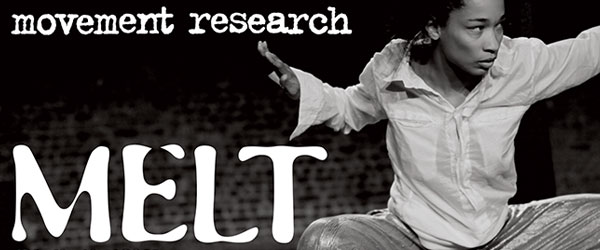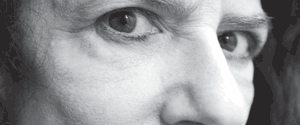Critical Correspondence
- MR Festival Spring 2008, slow walk
- Comments Off on MR Festival 2008: Slow Walk by Paulina Pobocha
- Writings
- 6.5.08
MR Festival 2008: Slow Walk by Paulina Pobocha
by Paulina Pobocha
MR Festival Spring 2008: Somewhere Out There
“Slow Walk” lead by Chris Peck and described on the Movement Research website as a “guided walking mediation” through the “neighborhood of the Judson Church” began at 6pm, Wednesday evening. Once the group of 12 assembled, Chris properly introduced the piece. The walk would in fact be a very slow one; snail’s pace, you might say. And the “neighborhood” mentioned on the website would be limited to the city block demarcated by West 4th street to the North, Thompson to the East, West 3rd to the South and Sullivan to the West. This is the block on which the Judson Church sits. Chris and the other curators had practiced, they would keep pace and we would circumnavigate the block in about 1 hour. It was starting to rain.
But, just before our epic journey around the block began, Chris read aloud to the group. First from Tich Nhat Hanh’s, The Long Road Turns to Joy: A Guide to Walking Meditation:
Happiness Is Not an Individual Matter
All our ancestors and all future generations are present in us. Liberation is not an individual matter. As long as the ancestors in us are still suffering, we cannot be happy, and we will transmit that suffering to our children and their children.
Now is the time to liberate our ancestors and future generations. It means to free ourselves. If we can take one step freely and happily, touching the Earth mindfully, we can take one hundred. We do it for ourselves and for all previous and future generations. We all arrive at the same time and find peace and happiness together!
Then, he offered more practical instruction from Pauline Oliveros:
Moving as slowly as possible, step forward with the heel to the ground first, let the weight of the body shift along the outside edge of the foot to the small toe and across to the large toe.
As the weight of the body fully aligns with that foot then begin the transition of shifting to the other foot.
Small steps are recommended as balance may be challenged.
Maintain good posture, with shoulders relaxed and head erect.
Use your breathing.
The challenge for this exercise is that no matter how slow you are walking, you can always go much slower.
Pointing to a potential contradiction, Peck returned to Nhat Hanh:
You don’t need to join your palms together or wear a solemn face to practice walking meditation. If possible, choose a quiet path in a park, near a lake, or along a riverbank.
The best practice is formless. Don’t walk so slowly that people think you are strange. Walk in a way that others do not even notice that you are practicing. If you meet someone along the way, just smile and continue your walking.
Off we were, with minds full.
And, almost immediately the import of as well as the sharp distinctions between the passages read by Peck came into the sharpest focus. How do you compromise form (Oliveros) with formlessness (Nhat Hanh) in the temperate drizzle of a June evening in Washington Square Park? The extreme slow pace of the walk, helped by the relatively numerous group of participants, precluded people not thinking we were strange. “Why are you walking so slowly?” was, at first, a constant refrain. I was skeptical of the meditative benefit and painfully, persistently aware of the spectator. And, then we turned the corner onto Thompson. Mid-way down the block the group started to thin. A few departed and individual paces started to find their own rhythms. We were no longer clustered in a tight, freakishly slow-moving group, but separated by space, distanced from one another. At some moment on West 3rd Street, my body came into focus, it was an effort to balance, an effort to move so slowly. The comments of the passersby waned and with them my self-consciousness. I thought about Bruce Nauman’s Walking in an Exaggerated Manner Around the Perimeter of a Square (substitute city block for square) and PaweÅ‚ Althamer’s Path for Sculpture Projects Münster. I thought about Richard Croft playing Gandhi in Satyagraha, slowly traversing the stage at the Met. Whether these are apt comparisons, I’m not sure, but an hour leaves you plenty of time to think.
At the end of the walk, I returned to what I perceived to be an incompatibility of the Oliveros and the Nhat Hanh passages. Despite the hour that had passed, they were still irreconcilable. Walking as slowly as Oliveros suggests with sustained attention to every movement seems difficult at best in a public setting or at least more effective in a private one. A move from private to public engenders concessions, a need, for instance, to draw less attention to one’s self, or, as Nhat Hanh puts it, to “smile” if you meet someone along the way, and even, as was my experience, to explain that you are practicing a walking meditation (which, I have to say, is not very meditative). The minutes during which I could focus on the movement of my body were the minutes away from curious eyes. Chris seemed to disagree. And at this moment, I realized that perhaps I was missing the point. The “Slow Walk” was not an exercise of logic, Peck’s readings were not clues for a puzzle yet to be solved. The one real rule was to walk slowly. Which I did, and enjoyed.


